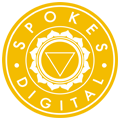The second generation of Web was developed to enable the users to participate, collaborate and share data in a social network. The advantages of uploading, downloading, editing data made users not only consume resources but also allows them to share resources. Blogs replaced static web pages and made users interact and share content collaboratively. Applications such as Facebook, Youtube, Del-icio-us, MySpace, Flickr, Freesound allow users to tag and share documents, photos, Music and URL’s in a collaborative environment and access them in public mode.
Then came the generation of mobility, it enables the users to keep devices always on connecting to the internet bringing desktop infrastructures to handheld devices. Though Web 3.0 remains on semantic annotations with folksonomy and social bookmarking services. But then it aimed to introduce more advanced 3D environments involving, holograms (physical structure diffracting light into an image) or augmented reality, binding the virtual world closer to the real world.
The Internet is instantaneously moving beyond it, and towards a new era. As it takes the notion of an ever-present internet to a new level. Smart devices not only use the internet, but speak to each other via machine-to-machine communication to accomplish tasks without the human interference. There is already an abundance of smart devices as well as automated, internet-connected systems that run without human input, such as automated building climate control.
There are various hi-tech and futuristic terms that are currently being used in relation to technology use. Web 5.0, the sensory and emotive Web, are specifically designed to develop computers that interact with human beings. This relationship will become a daily habit for many people. Although at the moment the Web is “emotionally” neutral, that is, it doesn’t perceive what users feel and although emotions are still difficult to track, there are already technologies that can measure their effects.
In Web 5.0, the next managerial challenge will be to truly tailor interactions to create rich, emotionally-resonant experiences for users. Almost everyone will be connected all of the time no matter where they are. Both Wearable technology and mobile technology are improving. The beginning of the new Internet has been happening ever since cell phones and wireless Internet gained popularity. Google’s update is just adapting to the new Internet. Implantable gadgets and technology were already here and will become more available as well. So, yes, in the future everyone will be connected in different ways. Today’s Internet is already used to monitor health, to help plan a day, to interact and locate other, to know when anyone meets with an accident or are stuck in an emergency situation. Wearable tech like Google Glass and Smart Watches allow you to gather information and communicate in a whole new way. There is even clothing available that connects you to the web in a variety of ways.
Today, we see even glimpses of this in online gaming environments. ECommerce will have to adapt even more to customize real-time communications with users. Web 5.0 will also put new demands on advertising, a major source of revenues on the Web. It too will be more targeted to the user’s level of arousal and receptivity to information. As with every prior transition, the sensory-emotive web has the potential to change the WWW from a raucous environment to a richer place of thoughtful and friendly interactions. It could also become a manipulative and disruptive space for individuals. Time will disclose how we use these new capabilities.




















